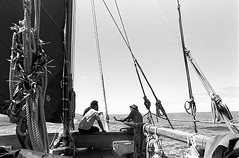The principles of wayfinding are simple; the practicalities are very complex." -- Nainoa Thompson
I went sailing this past Sunday. On the drive up to the lake we got talking about the skills of traditional Polynesian navigators. … rumor had it, they could see stars during the daytime. I spoke of what science tells us, that using our senses is a process of throwing out layer after layer of information - don’t use this, don’t use that. So, have we decided to throw out seeing stars during the day? It’s like that with learning a language. By the time a baby is about six months old, an English child can not distinguish between subtle Asian sounds. English babies actually can’t hear what Japanese babies can, and vice versa.
So, Monday morning I wanted to know if Polynesian navigators of the old school, could really see stars during the day. I never found that directly addressed on the Internet. What I did find was the work of the Polynesian Voyaging Society. They are trying to save traditional skills and teach a new generation.
What I realized is this skill of “wayfinding” is also a powerful metaphor for the navigation we all must do through Life. And so, I want to share the words of Nainoa Thompson here.
Nainoa Thompson, the first modern-day Polynesian to learn and use wayfinding for long-distance, open-ocean voyaging, studied wayfinding under Mau Piailug, a master navigator from the island of Satawal in Micronesia. Mau navigated the first voyage of the Hokule'a to Tahiti in 1976; Thompson was Hokule'a's wayfinder on the 1980 and 1985-87 voyages.
Wayfinding involves navigating on the open ocean without sextant, compass, clock, radio reports, or satellites reports. The wayfinder depends on observations of the stars, the sun, the ocean swells, and other signs of nature for clues to direction and location of a vessel at sea.
Tuesday, June 12, 2007
Subscribe to:
Post Comments (Atom)


No comments:
Post a Comment